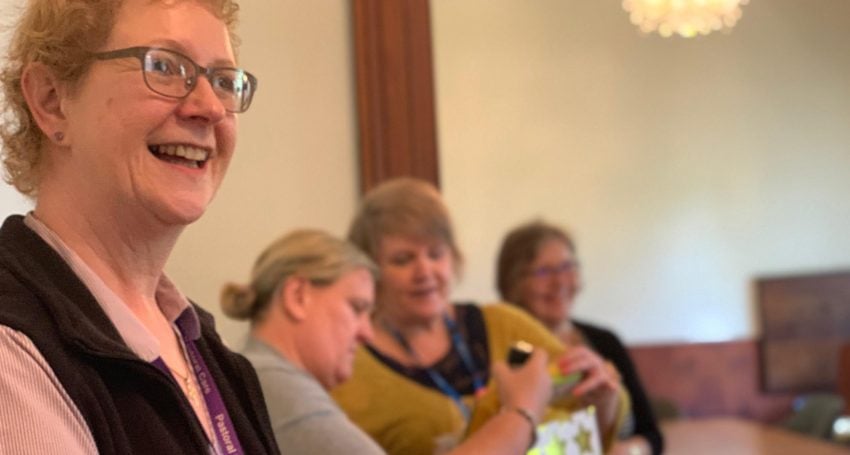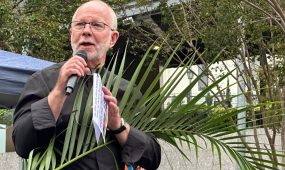Being Jesus’ hands and feet in our hospitals
Reflections
“Although we mostly visit Anglicans, there are some regulars – ‘frequent flyers’, we call them – who benefit from visits, as we walk alongside them on their journey of treatment. The people I feel who get the most from hospital chaplaincy are those who have left their faith behind at some point in their lives,” says retiring Hospital Chaplain and cancer survivor Judy Burt

While I have experienced a number of highlights and met many special people since commencing my hospital chaplaincy ministry in 2006, one woman in particular stands out. One day in 2017, I had a phone call from a local clergy person The Rev’d Jim Nolan, who had been advised by a friend in New Zealand that a woman had been ‘deplaned’ in Brisbane, alone and very unwell, from a flight travelling from Auckland to London. He asked if I would find her and look in on her. This traveller, Rose, having come through the Emergency Department, would not have turned up on my ‘Anglican list’, as Emergency staff don’t tend to ask which religion you are when you are in dire straits and time is of the essence. After I found Rose, she asked me to contact her UK-based sister, who was frantic when Rose failed to arrive at Heathrow Airport. I, and Rev’d Jim, then supported this lady through her surgery and subsequent recovery over a nine-week period until she was well enough to fly home to London with a nurse.
I thought that it was extraordinary that the strength of the Anglican connections enabled us to find out about, locate and assist Rose. Having a serious health issue, with her luggage having gone on to London (the airline delivered it to the hospital two days after her admission) and not knowing anyone in Brisbane, Rose needed help and care and God provided these in very practical ways. We were his hands and feet. Rose was very grateful for the medical and chaplaincy care she received at the Prince Charles Hospital. And, we were very pleased that she made it home safely back to her local congregation in London.
I started my journey towards becoming a hospital chaplain when I visited a friend who was in the palliative care ward at the Gold Coast Hospital in 2005. As both my parents were medical staff and because I had worked as a medical receptionist, I felt comfortable visiting hospital wards. When visiting my friend, I noticed that there were not many visitors to the palliative care ward and felt that with some training that I could become a hospital chaplain. I had seen a call-out for Anglican hospital visitors in the Parish of Southport pew bulletin, which was also circulated in my own parish pew bulletin at Surfers Paradise Anglican Church.
Advertisement
After talking to The Rev’d Sid Rogers, who was the then Diocesan Hospital Chaplaincy Team Leader, I completed his training for pastoral care visitors, which was a six-week course, if I remember correctly, at the Parish of Southport. The course convener then suggested I complete a year of chaplaincy training, which I did, before moving to the Sunshine Coast where I was offered a part-time role as Anglican Hospital Chaplain at Nambour Hospital. I left there four years later to move to Brisbane, where I worked in the same role at the Princess Alexandra Hospital and the Royal Brisbane and Women’s Hospital and also undertook some Anglicare community chaplaincy, before moving to the Prince Charles Hospital in 2016.
Most of the everyday visiting starts with the list of patients who have nominated themselves as ‘Anglicans’ and indicated their wish to receive visits from the chaplaincy team. After my bed-side visits, I then check the multifaith centre, ensuring that it is open and welcoming. I also follow up any messages left on the phone system from staff members about patients who have requested visits. Many of these calls are about patients who are not on any ‘religious list’ but are experiencing a crisis or loss or are upset or dying and need support and a kind ear to listen to them. If I have a volunteer rostered on, we decide who is visiting which wards that day and then we usually meet up for lunch to debrief. If it is the scheduled day for an ecumenical service, I will prepare the reading and a short reflection and we pray for the hospital and its staff, patients and patient relatives.
Advertisement
Although we mostly visit Anglicans, there are some regulars (‘frequent flyers’, we call them) who benefit from visits, as we walk alongside them on their journey of treatment. The people I feel who get the most from hospital chaplaincy are those who have left their faith behind at some point in their lives and realise, following a visit from a chaplain, that maybe there is more to faith than they thought – that faith can sustain them during difficult times and that there are people from the Church who care.
I feel that chaplaincy supports the mission of the Church in a major way. A hospital is a huge ‘mission field’, as there are hundreds of people who arrive at a hospital in sudden and dramatic ways and for life-changing treatment (Prince Charles Hospital is a lung and heart transplant hospital), and chaplains are there to discuss the difficult questions with them and offer hope. I am reminded of two Bible verses when I visit. The first is from Matthew 25.36, “I was sick and you took care of me”. The main scripture that I relate to most personally is 2 Corinthians 1.3-4:
“Blessed be the God and Father of our Lord Jesus Christ, the Father of mercies and the God of all consolation, who consoles us in all our affliction, so that we may be able to console those who are in any affliction with the consolation with which we ourselves are consoled by God.”
This scripture makes total sense to me and my chaplaincy work.
My own serious health setbacks have strengthened my hospital chaplaincy ministry and my own faith. I had been working as a hospital chaplain before I was diagnosed with breast cancer in 2011. While I was supported through my cancer treatment by my colleagues, friends and family, talking to cancer survivors who had completed their treatment gave me the most encouragement. So, when I returned to volunteering at the Royal Brisbane and Women’s Hospital, I felt called to visit patients who were undergoing similar treatment to offer them encouragement and hope. I feel that chaplains are people of hope, in whatever circumstances. All through my own breast cancer journey, I felt that my God was with me.
I recommend chaplaincy either as a career or as a voluntary role because I feel passionately that people should have a choice to be able to see a chaplain when they need bed-side ministry support. Many patients I see would not call themselves ‘people of faith’, but when life is difficult they often want to discuss their spiritual questions and worries. I am also passionate about helping chaplaincy students (CPE students) learn the hospital chaplaincy ropes.
The book Communicating with dying people and their relatives, which is edited by Jean Lugton, says that:
“Spirituality has become less visible in our healthcare institutions and has increasingly come to be considered a very personal and private matter. People’s spiritual needs are not always very apparent and can be overlooked because of the intensity of medical and nursing care. For spiritual care to be helpful, it has to be seen as available to those who may be seeking it.”
So, I pray that chaplaincy will always be available in our hospitals.
Note from Chaplaincy Services Manager, Andrea Colledge: On behalf of the Parishes and Other Mission Agencies Commission (PMC), I would like to thank retiring Chaplain and Hospital Coordinator Judy Burt for her unwavering commitment to this very important ministry.
For more information on chaplaincy careers and volunteer roles, please email chaplaincy@anglicanchurchsq.org.au.





